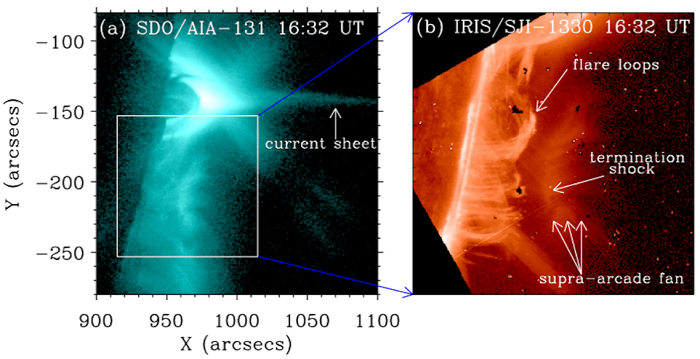Solar flares are violent eruptive phenomena in the solar system and are considered as the effective particle accelerators. In solar flare models, termination shocks (TSs) are often regarded as a possible driver for particle acceleration. Studies on TSs are mainly theoretical and through numerical experiments and radio observations. Few studies have investigated them by using optical imaging observations.
Observations have proved that a distributed structure named supra-arcade fan (SAF) exists between the bottom tip of current sheet (CS) during a solar flare and the top of the flare loop system, and the spatial location of the SAF is generally considered to be consistent with sources of high energy particles (such as hard X-ray sources, radio sources, microwave sources).
In a study published in Monthly Notices of the Royal Astronomical Society, Prof. LIN Jun and his PhD student CAI Qiangwei from Yunnan Observatories of the Chinese Academy of Sciences and collaborators from the Harvard-Smithsonian Center for Astrophysics, the Leibniz-Institut fuer Astrophysik Potsdam and the Katholieke Universiteit Leuven investigated a SAF above the top of the flare loop system observed in extreme ultraviolet (EUV) images of the Sun, and reported that it could be the region where the TSs exists.
The research revealed that the presence of a TS formed in a high-temperature structure (up to 10 million Kelvin) called SAF. This discovery was made possible by combining computer simulations of the 2017 September 10 solar flare using the ATHENA numerical code with EUV observations of the event by the Solar Dynamic Observatory (SDO), the Interface Region Imaging Spectrograph (IRIS), and Hinode.
While solar scientists have long known that magnetic reconnection is responsible for the occurrence of solar flares, understanding the actual physical regime involved and its observable consequences have been challenging. The new modeling results revealed that the SAF undergoes quasi-periodic oscillations, which are confirmed by the relevant observations of the solar flare in the EUV.
This study suggests that the magnetic energy release and conversion during a solar flare proceeds in an impulsive, bursty-like fashion, which could be due to the fact that the reconnection region in the CS is highly turbulent and consists of intermittent features. The discovery was made possible by the aid of computer modeling, which showcases the importance of numerical simulations when analyzing and interpreting complex solar observations.

Figure 1. The major eruptive process on the 2017 September 10 event created a very fast coronal mass ejection (out of the scope of the images here), a flare loop system, the reconnecting current sheet, the supra-arcade fan structure, and the termination shock, observed by the SDO (a) and the IRIS (b). (Image by CAI Qiang wei)
Contact:
CAI Qiangwei, YNAO, CAS
caiqiangwei@ynao.ac.cn